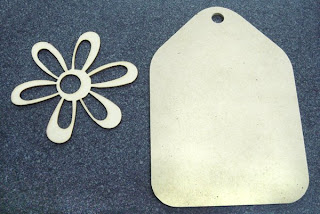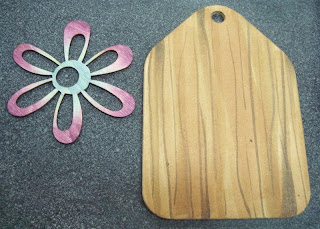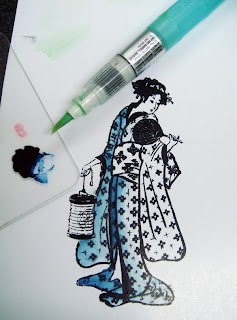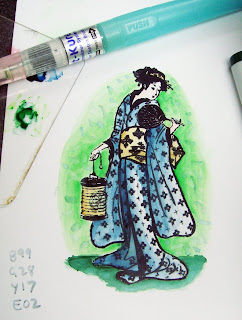 I think my head is finally getting back in the swing of things after the frantic days of CHA. Here is a quick, very simple tutorial. A couple months ago I showed how to color something to make it look like wood, here I am coloring on wood to make it look like wood. Since Copic markers are alcohol based, they work on many surfaces that water-based would not look as clean on.
I think my head is finally getting back in the swing of things after the frantic days of CHA. Here is a quick, very simple tutorial. A couple months ago I showed how to color something to make it look like wood, here I am coloring on wood to make it look like wood. Since Copic markers are alcohol based, they work on many surfaces that water-based would not look as clean on. Wood tag project
Wood tag projectLarge wood tag by Kaiser crafts: E33 Wide, E55, E44. I started by coloring the background with my wide E33.
I was streaky because I wanted it to look like wood grain. Then I added some streaks of E55 and last, some darker tones with E44. I was careful to keep all my streaks in the same direction, but also uneven (Look at my post on coloring wood for a stepped-out diagram of how to color wooden-looking things).
 Note that I used a little less of each darker tone, so that the overall effect is one of wood. You should test your browns since each blending family will feel a little different, but they don't always follow the rule of thumb about adding grays as you jump from one family to the next (like from the 40's to the 50's). In this case, the E44 has more gray than the E55, so it seems darker on the project. By adding E44 last it kept the edges on those thin streaks crisp. If I added the dark first it would soften my crisp lines when I added the lighter colors. I darkened the edge of the whole piece with the E44 so it matched the flower better.
Note that I used a little less of each darker tone, so that the overall effect is one of wood. You should test your browns since each blending family will feel a little different, but they don't always follow the rule of thumb about adding grays as you jump from one family to the next (like from the 40's to the 50's). In this case, the E44 has more gray than the E55, so it seems darker on the project. By adding E44 last it kept the edges on those thin streaks crisp. If I added the dark first it would soften my crisp lines when I added the lighter colors. I darkened the edge of the whole piece with the E44 so it matched the flower better.Wood Flower by Kaiser crafts: B34, V06. Since this wasn't made of bits of ground-up wood like the tag it absorbed the color different. The marker dyes flowed more with the grain of the wood, while the other piece stayed fairly crisp and clean.
Chipboard Letter, K & Co: Colored with V06, RV29. This started out a light blue, so all I needed to do was add purple to get it to match the flower, then I had to tone the purple more pink with an RV29. I wiped off dense color with a wadded tissue soaked in blender.
 Colors change on different Surfaces
Colors change on different SurfacesPeople are always asking me to match Copic colors to specific things, papers, inks etc. I must say that this is very difficult, even under the best of circumstances. Anything you color on will pick up color in a unique way.
 On this project, the little chipboard letter picked up color very differently than the Wood flower. I used the same purple on the letter that I did on the flower. Not the same looking though! I had to dab in a bit of RV29 to tone the purple so it was more pink/purple like the wood showed, since the glossy paper of the letter and the absorbent wood flower take in color in different ways.
On this project, the little chipboard letter picked up color very differently than the Wood flower. I used the same purple on the letter that I did on the flower. Not the same looking though! I had to dab in a bit of RV29 to tone the purple so it was more pink/purple like the wood showed, since the glossy paper of the letter and the absorbent wood flower take in color in different ways.Real wood versus fibers will also pick up the dyes differently. My purple is stronger on the flower than it would be on the other piece of wood. It really depends on what each item is made from.
When you make a personal color chart, use the paper YOU use most often. If you print it out on a different paper some colors may not look the same, especially on thicker cardstocks. Keep this in mind when matching colors across media as well. You won't get it exact without some trial and error.
My final background paper layer is some tracing vellum that I wrinkled up and colored with the bue and purple markers again to get a spotty, grunged-up look that is more see-through in real-life. The big green glass bead is one that I stole from a vase here in my office. I thought it nicely added to the piece. I haven't glued the whole thing in place yet, since I'm still debating wether to add more bling or not. One part of me says "leave good enough alone" the other half of me says "go for it! add more stuff!" we'll see which wins out. Have a great weekend!

 In addition to photos, I have a rare treat-
In addition to photos, I have a rare treat- 









































